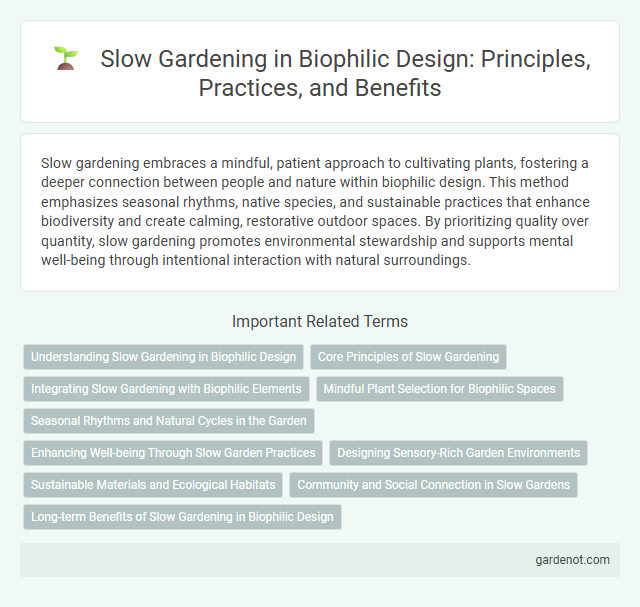Slow gardening embraces a mindful, patient approach to cultivating plants, fostering a deeper connection between people and nature within biophilic design. This method emphasizes seasonal rhythms, native species, and sustainable practices that enhance biodiversity and create calming, restorative outdoor spaces. By prioritizing quality over quantity, slow gardening promotes environmental stewardship and supports mental well-being through intentional interaction with natural surroundings.
Understanding Slow Gardening in Biophilic Design
Slow gardening in biophilic design emphasizes mindful interaction with nature, fostering deeper emotional connections and enhancing well-being through deliberate, unhurried gardening practices. It promotes the use of native plants and ecological principles to create sustainable, resilient landscapes that support biodiversity and natural ecosystems. This approach aligns with biophilic design by integrating natural elements that nurture both environmental health and human tranquility.
Core Principles of Slow Gardening
Slow gardening embraces mindfulness, sustainability, and connection to nature, prioritizing patient cultivation and ecological balance. This approach encourages seasonal awareness, minimal intervention, and fostering biodiversity to create thriving, resilient gardens. Rooted in appreciation for natural rhythms, slow gardening supports mental well-being and deepens human-nature relationships.
Integrating Slow Gardening with Biophilic Elements
Integrating slow gardening with biophilic design enhances well-being by fostering deep connections with nature through mindful, deliberate cultivation practices. Emphasizing native plants, natural textures, and organic rhythms in slow gardening aligns with biophilic principles, promoting biodiversity and ecological harmony within garden spaces. This fusion supports mental restoration, sensory engagement, and sustainable living, creating environments that nurture both people and the planet.
Mindful Plant Selection for Biophilic Spaces
Mindful plant selection in slow gardening emphasizes choosing species that promote sensory engagement and emotional well-being in biophilic spaces. Prioritizing native, low-maintenance plants enhances biodiversity while fostering a deeper connection between individuals and nature. This intentional approach supports sustainable practices and cultivates tranquil, restorative environments.
Seasonal Rhythms and Natural Cycles in the Garden
Slow gardening embraces seasonal rhythms and natural cycles by aligning planting and maintenance with the inherent patterns of nature. This approach fosters biodiversity, improves soil health, and enhances the garden's resilience by respecting phenological stages and climate variations. Emphasizing the timing of growth, flowering, and dormancy supports ecological balance and a deeper connection to the environment.
Enhancing Well-being Through Slow Garden Practices
Slow gardening nurtures mindfulness by encouraging gardeners to engage deeply with nature, promoting stress reduction and mental clarity. This intentional practice enhances well-being through careful observation, sensory immersion, and sustainable plant care. Emphasizing patience and connection, slow gardening fosters a harmonious relationship between humans and the natural environment.
Designing Sensory-Rich Garden Environments
Slow gardening emphasizes creating sensory-rich garden environments that engage sight, touch, smell, and sound to foster deep connections with nature. Designing with diverse plant textures, fragrant blossoms, and natural materials encourages mindfulness and relaxation while enhancing biodiversity and ecological balance. Integrating water features and wildlife habitats further stimulates sensory experiences, promoting well-being and immersion in vibrant outdoor spaces.
Sustainable Materials and Ecological Habitats
Slow gardening in biophilic design emphasizes the use of sustainable materials such as reclaimed wood, natural fibers, and biodegradable planters to reduce environmental impact. It promotes creating ecological habitats by cultivating native plants that support local wildlife and enhance biodiversity. This approach fosters a harmonious connection between humans and nature, encouraging mindful, low-impact gardening practices that maintain ecosystem health.
Community and Social Connection in Slow Gardens
Slow gardening fosters strong community bonds by encouraging shared gardening activities that enhance social connection and collective well-being. Integrating biophilic principles, slow gardens create inviting green spaces where neighbors collaborate, exchange knowledge, and build lasting relationships. These environments support mental health and social resilience through immersive interaction with nature and purposeful, mindful cultivation.
Long-term Benefits of Slow Gardening in Biophilic Design
Slow gardening in biophilic design enhances well-being by fostering deeper connections to nature through mindful, deliberate cultivation processes. The practice encourages biodiversity, improves soil health, and supports sustainable ecosystems, contributing to resilient and thriving green spaces over time. Emphasizing patience and natural rhythms, slow gardening promotes mental restoration and environmental stewardship crucial for long-term ecological benefits.
Slow gardening Infographic

 gardenot.com
gardenot.com